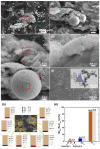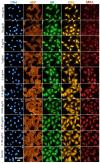A Novel Nanosafety Approach Using Cell Painting, Metabolomics, and Lipidomics Captures the Cellular and Molecular Phenotypes Induced by the Unintentionally Formed Metal-Based (Nano)Particles
- PMID: 36672217
- PMCID: PMC9856453
- DOI: 10.3390/cells12020281
A Novel Nanosafety Approach Using Cell Painting, Metabolomics, and Lipidomics Captures the Cellular and Molecular Phenotypes Induced by the Unintentionally Formed Metal-Based (Nano)Particles
Abstract
Additive manufacturing (AM) or industrial 3D printing uses cutting-edge technologies and materials to produce a variety of complex products. However, the effects of the unintentionally emitted AM (nano)particles (AMPs) on human cells following inhalation, require further investigations. The physicochemical characterization of the AMPs, extracted from the filter of a Laser Powder Bed Fusion (L-PBF) 3D printer of iron-based materials, disclosed their complexity, in terms of size, shape, and chemistry. Cell Painting, a high-content screening (HCS) assay, was used to detect the subtle morphological changes elicited by the AMPs at the single cell resolution. The profiling of the cell morphological phenotypes, disclosed prominent concentration-dependent effects on the cytoskeleton, mitochondria, and the membranous structures of the cell. Furthermore, lipidomics confirmed that the AMPs induced the extensive membrane remodeling in the lung epithelial and macrophage co-culture cell model. To further elucidate the biological mechanisms of action, the targeted metabolomics unveiled several inflammation-related metabolites regulating the cell response to the AMP exposure. Overall, the AMP exposure led to the internalization, oxidative stress, cytoskeleton disruption, mitochondrial activation, membrane remodeling, and metabolic reprogramming of the lung epithelial cells and macrophages. We propose the approach of integrating Cell Painting with metabolomics and lipidomics, as an advanced nanosafety methodology, increasing the ability to capture the cellular and molecular phenotypes and the relevant biological mechanisms to the (nano)particle exposure.
Keywords: additive manufacturing; high-content screening (HCS); inflammation; multivariate analysis; nanoparticle emissions; new approach methodologies (NAMs); targeted metabolomics.
Conflict of interest statement
Authors H.A. and J.F. are employed by Uddeholms AB. The remaining authors declare that the research was conducted in the absence of any conflict of interest. The funders had no role in the design of the study; in the collection, analyses, or interpretation of the data; in the writing of the manuscript; or in the decision to publish the results.
Figures






References
-
- Wong K.V., Hernandez A. A review of additive manufacturing. Int. Sch. Res. Not. 2012;2012:208760. doi: 10.5402/2012/208760. - DOI
-
- Kumar S.P., Elangovan S., Mohanraj R., Ramakrishna J.R. Review on the evolution and technology of State-of-the-Art metal additive manufacturing processes. Mater. Today Proc. 2021;46:7907–7920. doi: 10.1016/j.matpr.2021.02.567. - DOI
-
- Alijagic A., Scherbak N., Kotlyar O., Karlsson P., Persson A., Hedbrant A., Norinder U., Larsson M., Felth J., Andersson L., et al. Cell Painting unveils cell response signatures to (nano) particles formed in additive manufacturing. Toxicol. Lett. 2022;368:S226–S227. doi: 10.1016/j.toxlet.2022.07.611. - DOI
-
- Alijagic A., Engwall M., Särndahl E., Karlsson H., Hedbrant A., Andersson L., Karlsson P., Dalemo M., Scherbak N., Färnlund K., et al. Particle safety assessment in additive manufacturing: From exposure risks to advanced toxicology testing. Front. Toxicol. 2022;4:836447. doi: 10.3389/ftox.2022.836447. - DOI - PMC - PubMed
-
- Runström Eden G., Tinnerberg H., Rosell L., Möller R., Almstrand A.C., Bredberg A. Exploring Methods for Surveillance of Occupational Exposure from Additive Manufacturing in Four Different Industrial Facilities. Ann. Work Expo. Health. 2022;66:163–177. doi: 10.1093/annweh/wxab070. - DOI - PMC - PubMed
Publication types
MeSH terms
LinkOut - more resources
Full Text Sources

